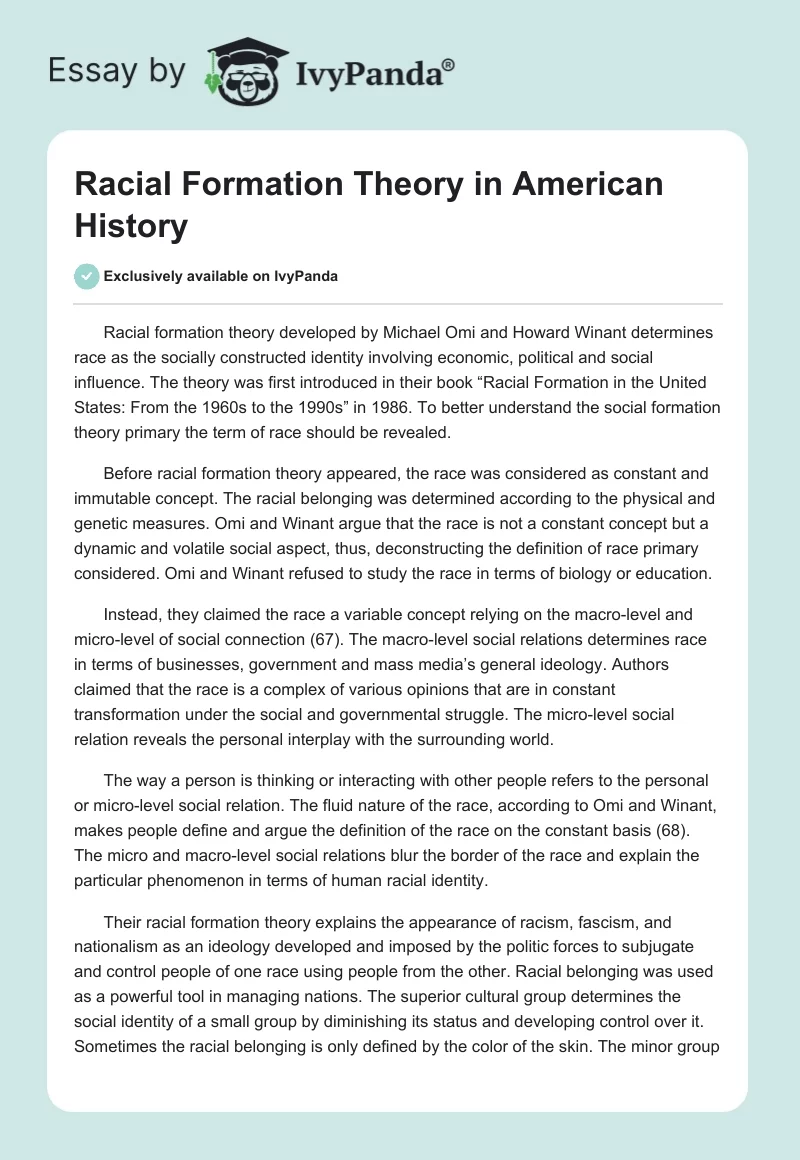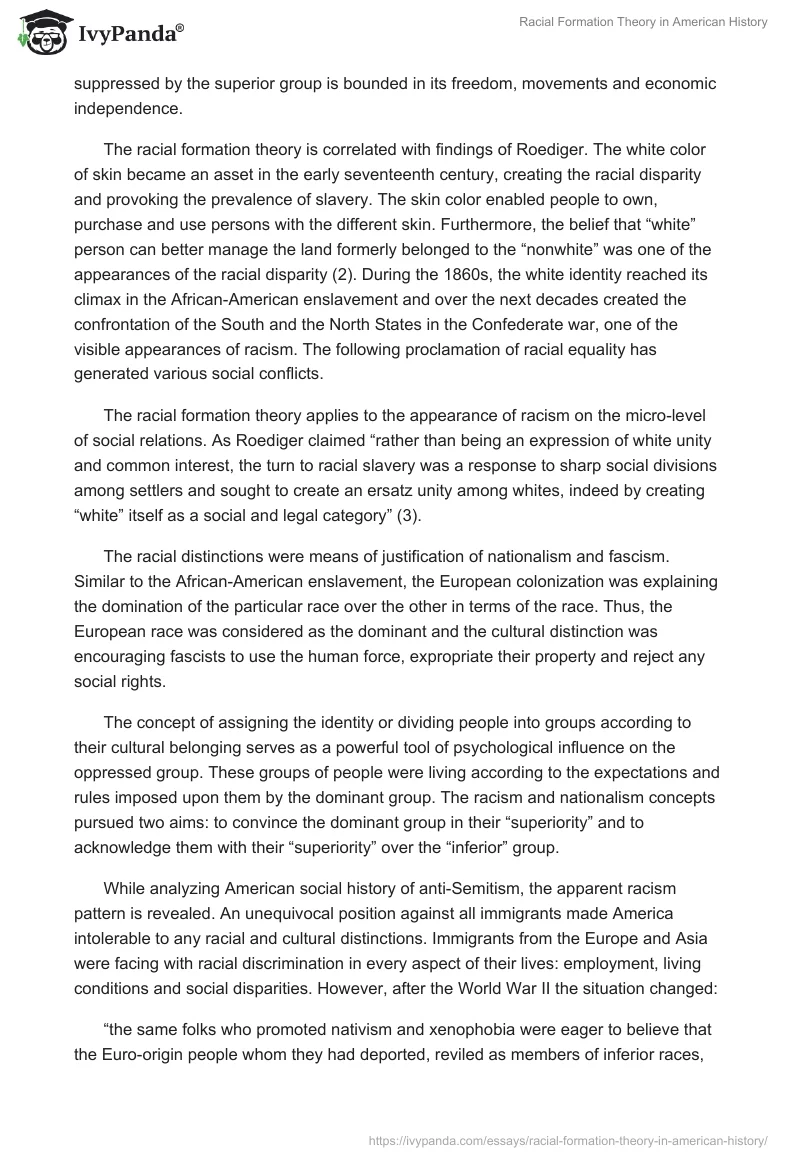Racial formation theory developed by Michael Omi and Howard Winant determines race as the socially constructed identity involving economic, political and social influence. The theory was first introduced in their book “Racial Formation in the United States: From the 1960s to the 1990s” in 1986. To better understand the social formation theory primary the term of race should be revealed.
Before racial formation theory appeared, the race was considered as constant and immutable concept. The racial belonging was determined according to the physical and genetic measures. Omi and Winant argue that the race is not a constant concept but a dynamic and volatile social aspect, thus, deconstructing the definition of race primary considered. Omi and Winant refused to study the race in terms of biology or education.
Instead, they claimed the race a variable concept relying on the macro-level and micro-level of social connection (67). The macro-level social relations determines race in terms of businesses, government and mass media’s general ideology. Authors claimed that the race is a complex of various opinions that are in constant transformation under the social and governmental struggle. The micro-level social relation reveals the personal interplay with the surrounding world.
The way a person is thinking or interacting with other people refers to the personal or micro-level social relation. The fluid nature of the race, according to Omi and Winant, makes people define and argue the definition of the race on the constant basis (68). The micro and macro-level social relations blur the border of the race and explain the particular phenomenon in terms of human racial identity.
Their racial formation theory explains the appearance of racism, fascism, and nationalism as an ideology developed and imposed by the politic forces to subjugate and control people of one race using people from the other. Racial belonging was used as a powerful tool in managing nations. The superior cultural group determines the social identity of a small group by diminishing its status and developing control over it. Sometimes the racial belonging is only defined by the color of the skin. The minor group suppressed by the superior group is bounded in its freedom, movements and economic independence.
The racial formation theory is correlated with findings of Roediger. The white color of skin became an asset in the early seventeenth century, creating the racial disparity and provoking the prevalence of slavery. The skin color enabled people to own, purchase and use persons with the different skin. Furthermore, the belief that “white” person can better manage the land formerly belonged to the “nonwhite” was one of the appearances of the racial disparity (2). During the 1860s, the white identity reached its climax in the African-American enslavement and over the next decades created the confrontation of the South and the North States in the Confederate war, one of the visible appearances of racism. The following proclamation of racial equality has generated various social conflicts.
The racial formation theory applies to the appearance of racism on the micro-level of social relations. As Roediger claimed “rather than being an expression of white unity and common interest, the turn to racial slavery was a response to sharp social divisions among settlers and sought to create an ersatz unity among whites, indeed by creating “white” itself as a social and legal category” (3).
The racial distinctions were means of justification of nationalism and fascism. Similar to the African-American enslavement, the European colonization was explaining the domination of the particular race over the other in terms of the race. Thus, the European race was considered as the dominant and the cultural distinction was encouraging fascists to use the human force, expropriate their property and reject any social rights.
The concept of assigning the identity or dividing people into groups according to their cultural belonging serves as a powerful tool of psychological influence on the oppressed group. These groups of people were living according to the expectations and rules imposed upon them by the dominant group. The racism and nationalism concepts pursued two aims: to convince the dominant group in their “superiority” and to acknowledge them with their “superiority” over the “inferior” group.
While analyzing American social history of anti-Semitism, the apparent racism pattern is revealed. An unequivocal position against all immigrants made America intolerable to any racial and cultural distinctions. Immigrants from the Europe and Asia were facing with racial discrimination in every aspect of their lives: employment, living conditions and social disparities. However, after the World War II the situation changed:
“the same folks who promoted nativism and xenophobia were eager to believe that the Euro-origin people whom they had deported, reviled as members of inferior races, and prevented from immigrating only a few years earlier, were now model middle-class white suburban citizens” (Brodkin 39).
Racial discriminations affected not only African-Americans or Europeans but also Asians. Zhou describes the settlement and “whitening” of Asians as a long-lasting process involving the generations of ancestors. “Even today, many Americans see Asians as “forever foreign” (Zhou 29). The several generations of Asians permanently living in America have been labeled Asian Americans.
Despite the fact that some Asians may be living in America longer than many Americans of Europe ancestry, the attitude toward them is still biased. Thus, the racist “minority model” appeared in the 1960s referred Asians to “other”. The constant discrimination of civil rights, employment, and economic opportunities eventually made Asians successful and wealthy. Furthermore, in several years, American mass media could appreciate Asian’s work capacity and respect their hard work in contrast to other minorities group.
The racism manifestations during the 1940s also affected Mexican Americans. The equal human rights promised by American constitution were completely ignored. Mexican Americans were harassed and treated poorly and “American institutions were unequal with regard to racial minorities” (Sanchez 254). The society was imposing upon Mexican adolescents particular expectations. These, contrary sometimes, cultural models did not give a clear understanding of the own ethnic identity and often led to the personal conflict.
“Though they [adolescents] were concerned with the balance between what was Mexican in one’s past with what was “American” in one’s present, they were concerned about the future and what the term “Mexican American” implied” (Sanchez 255). The racist phenomena continued over decades, and the attitude toward the new generation of Mexican Americans did not change. Furthermore, the construction of the Border between America and Mexico showed unambiguous reluctance of letting Mexican immigrants, and American explicit anti-immigration policy.
The cultural development of young Mexican people often provokes a personal conflict and influences on the racial identification. “Now as in the past, the typical migrant is a working-age male from western Mexico” (Durand, Massey and Zenteno 124). The portrait of Mexican immigrant described above represents the classic Mexican American shifting from Mexico to America in search for better working opportunities or living conditions.
The process of becoming a citizen is related to micro and macro-level social relations as Omi and Winant have established. Thus, the racial identification should be based on social meaning rather than biological or ethnical features. The cultural adaptability of Mexican Americans along with other ethnic minorities involved several generations and extreme hardships on their way to becoming Americans. However, the prefix Asian, African or Mexican before American still reveals the prejudice racial attitude.
The Omi’s and Winant’s racial formation thesis explains cases of racism and fascism as a political struggle where race is considered as leverage on the minor social group. Thus, the phenomena of African-American’s enslavement, harassment of Mexican Americans and depriving Asian Americans of the economic achievements get the social justification. Fascist’s phenomenon, on the other hand, is a macro-level social relation that affects the societal ideology and spreads on the dominant group giving them a full control over the oppressed group.
The Jews harassments during the war revealed the force of the racial identification of a superior race and provided the government with the powerful tool for maintaining the control over the minor cultural group. African-American’s enslavement, however, referred to the micro-level social relations, where the white skin color was considered as an asset and was enabling “white” person to own, trade and exploit the work of African-Americans. Land expropriation formerly belonged to “nonwhites”, was justified by the racial belonging and African-Americans were permanently deprived of all human rights.
Works Cited
Brodkin, Karen. How Jews Became White Folks and What That Says about Race in America. New Brunswick: Rutgers University Press, 1998. Print.
Durand, Jorge, Massey, Douglas and Rene M. Zenteno. “Mexican Immigration to the United States: Continuities and Changes”. Latin American Research Review 36.1 (2001): 107-127. Print.
Omi, Michael, and Howard Winant. Racial Formation in the United States: From the 1960s to the 1990s. New York: Routledge, 1994. Print.
Roediger, David R. How Race Survived US History: From Settlement and Slavery to the Obama Phenomenon. London: Verso, 2008. Print.
Sanchez, George J. Becoming Mexican American Ethnicity, Culture, and Identity in Chicano Los Angeles, 1900-1945. New York: Oxford University Press, 1995. Print.
Zhou, Min. “Are Asian Americans Becoming “white?”. Contexts 3.1 (2003): 29-37. Print.



